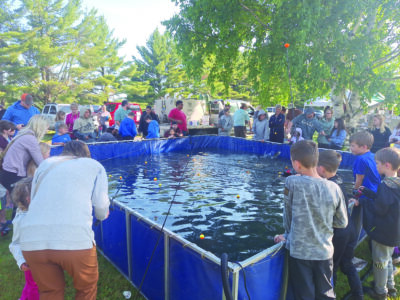COVID affects Tech enrollment less than feared

Garrett Neese/Daily Mining Gazette Phillip Cauley, a member of Michigan Technological University’s Mind Trekkers club, sets off a liquid nitrogen explosion during a demonstration at K-Day in September.
al University saw only a slight decline in student numbers, ahead of where the university had projected it would be as a result of the COVID-19 pandemic.
Enrollment is at 6,867 students, down 170 students from last fall, John Lehman, vice president for university relations and enrollment, said at Friday’s Tech Board of Control meeting. Most of that drop comes from international students, who are down 161, Lehman said.
“Most of those are incoming international students who found it problematic to get into the country to attend classes here,” Lehman said.
Undergraduate enrollment declined by about 2%, while graduate enrollment dropped 4%.
The drop in international students accounted for the graduate decline; domestic graduate enrollment had actually gone up, Lehman said.
The first- and second-year retention number of 85.7% is near an all-time high, Lehman said.
Larger increases came in the College of Computing, as well as the College of Forestry and Environmental Science and College of Sciences and Arts.
New programs have also seen growth. The cybersecurity program, which had 13 students when it debuted last year, grew to 40 this fall. Computer science and software engineering programs also grew, Lehman said.
The university is also making progress towards its goals of higher enrollment numbers for women and underrepresented minorities, Lehman said. The percentage of female students is at a high of 29.3%, though actual numbers fell slightly. That’s close to the 30% goal set by the university’s Diversity Council set four years ago as a goal for 2025.
The same committee also set goals for ethnic diversity. Domestic underrepresented students are up to 10.4%, though still short of the 13% goal set for 2025.
“This is an all-time high, both in terms of numbers and in terms of proportions,” Lehman said.
The number of applications for this year reached an all-time high of 8,404, rising more than 27%. Paid deposits declined by about 6%.
In the spring, Tech’s middle-of-the-road projections budgeted for a 13% to 16% decline in incoming freshmen. The actual decline of about 7% — 100 or so students — was close to their optimistic scenario, Lehman said.
“Talking to some of my peers around the state, many of the schools are seeing 15, 17, 18% declines in their freshman average, and it’s nice to see we outperformed that statewide average as well,” he said.
The freshman class’s 13% average of underrepresented students, up from 11.5% last year, is an all-time high, Lehman said, which he attributed in part to the work the Tech Forward initiative on diversity and inclusion had done with the admissions office, which included engaging alumni in Grand Rapids and the Twin Cities area to recruit.
“We’re looking forward to expanding that into the southeast corner of Michigan this coming recruiting cycle,” he said.
Incoming freshmen’s GPA averaged 3.80, the fifth straight increase. Nearly 29% of freshmen were in the top of five academic tiers, despite the university recalibrating those tiers several years ago to make it more difficult, Lehman said.
“Hopefully that will translate into a continued strong freshman, sophomore retention,” he said.
Prospective students continue to visit Tech, which is one of the few universities in the state offering campus tours, Lehman said. Campus visits are expected to be about half of normal, he said.
With students having difficulty scheduling standardized tests, Tech moved to a test-optional review of applications. About 2,000 students have been admitted for next year already, a 5% increase over last year, Lehman said.
Tech hopes to see 5% growth in the coming academic year, continuing toward a record freshman class in 2024.
Asked how the university was normalizing for the variety of a high-school GPA without standardized tests, Lehman said the university ran models using the early high-school stats of students in their admittance pool to see how admittance numbers would have differed.
About 98% of the acceptance decisions would have been the same, Lehman said.
Most of the variance was from students with high GPA and low test scores. With those, Lehman said, the admissions team digs deeper to look at scores in math and science classes, and also whether the student’s GPA had been on a rising or falling trend.
Most of Tech’s colleges didn’t see a significant change when those applicants were compared to the new admissions standard. Demographics stayed about the same, Lehman said.
“If anything, they tended to benefit students from smaller schools and students from urban schools as well,” he said. “And in addition, they tended to benefit female students as well.”





